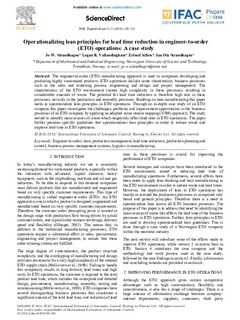| dc.contributor.author | Strandhagen, Jo Wessel | |
| dc.contributor.author | Vallandingham, Logan Reed | |
| dc.contributor.author | Alfnes, Erlend | |
| dc.contributor.author | Strandhagen, Jan Ola | |
| dc.date.accessioned | 2018-10-17T11:44:00Z | |
| dc.date.available | 2018-10-17T11:44:00Z | |
| dc.date.created | 2018-09-25T13:14:44Z | |
| dc.date.issued | 2018 | |
| dc.identifier.citation | IFAC-PapersOnLine. 2018, 51 (11), 128-133. | nb_NO |
| dc.identifier.issn | 2405-8963 | |
| dc.identifier.uri | http://hdl.handle.net/11250/2568467 | |
| dc.description.abstract | The engineer-to-order (ETO) manufacturing approach is used in companies developing and producing highly customized products. ETO operations include some characteristic business processes such as the sales and tendering process, engineering and design and project management. The characteristics of the ETO environment creates high complexity in these processes, resulting in considerable amounts of waste. The potential for lead time reduction is therefore high also in these processes, not only in the production and assembly processes. Building on lean manufacturing this paper seeks to operationalize lean principles in ETO operations. Through an in-depth case study of an ETO company this paper investigates the challenges, problems and improvement opportunities in the business processes of an ETO company by applying an adapted value stream mapping (VSM) approach. The study served to identify main sources of waste which negatively affect lead time in ETO operations. The paper further presents specific guidelines that operationalizes lean principles in order to reduce waste and improve lead time in ETO operations. | nb_NO |
| dc.language.iso | eng | nb_NO |
| dc.publisher | International Federation of Automatic Control (IFAC) | nb_NO |
| dc.title | Operationalizing lean principles for lead time reduction in engineer-to-order (ETO) operations: A case study | nb_NO |
| dc.title.alternative | Operationalizing lean principles for lead time reduction in engineer-to-order (ETO) operations: A case study | nb_NO |
| dc.type | Journal article | nb_NO |
| dc.type | Peer reviewed | nb_NO |
| dc.description.version | publishedVersion | nb_NO |
| dc.source.pagenumber | 128-133 | nb_NO |
| dc.source.volume | 51 | nb_NO |
| dc.source.journal | IFAC-PapersOnLine | nb_NO |
| dc.source.issue | 11 | nb_NO |
| dc.identifier.doi | https://doi.org/10.1016/j.ifacol.2018.08.246 | |
| dc.identifier.cristin | 1613388 | |
| dc.description.localcode | © 2018, IFAC (International Federation of Automatic Control) Hosting by Elsevier Ltd. | nb_NO |
| cristin.unitcode | 194,64,92,0 | |
| cristin.unitcode | 194,60,25,0 | |
| cristin.unitname | Institutt for maskinteknikk og produksjon | |
| cristin.unitname | Institutt for industriell økonomi og teknologiledelse | |
| cristin.ispublished | true | |
| cristin.fulltext | original | |
| cristin.qualitycode | 1 | |
